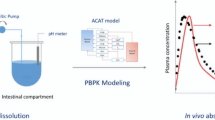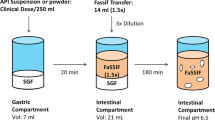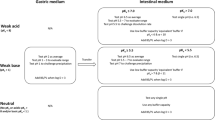Abstract
This work describes an exploratory experimental and in silico study of the influence of polymorphism, particle size, and physiology on the pharmacokinetics of lercanidipine hydrochloride (LHC). Equilibrium and kinetic solubility studies were performed on LHC forms I and II, as a function of pH and buffer composition. GastroPlus® was used to evaluate the potential effect of solubility differences due to polymorphism, particle size, and physiological conditions, on the drug pharmacokinetics. The results indicated that solubilities of LHC polymorphs are strongly dependent on the composition and pH of the buffer media. The concentration ratio (CI/CII) is particularly large for chloride buffer (CI/CII = 3.3–3.9) and exhibits a slightly decreasing tendency with the pH increase for all other buffers. Based on solubility alone, a higher bioavailability of form I might be expected. However, exploratory PBPK simulations suggested that (i) under usual fasted (pH 1.3) and fed (pH 4.9) gastric conditions, the two polymorphs have similar bioavailability, regardless of the particle size; (ii) at high gastric pH in the fasted state (e.g., pH 3.0), the bioavailability of form II can be considerably lower than that of form I, unless the particle size is < 20 μm. This study demonstrates the importance of investigating the effect of the buffer nature when evaluating the solubility of ionizable polymorphic substances. It also showcases the benefits of using PBPK simulations, to assess the risk and pharmacokinetic relevance of different solubility and particle size between crystal forms, for diverse physiological conditions.








Similar content being viewed by others
Abbreviations
- API:
-
Active pharmaceutical ingredient
- AUC0→t :
-
The area under the concentration-time curve from zero up to the last time point
- BCS:
-
Biopharmaceutics Classification System
- C l :
-
Drug concentration in the lumen compartment
- C max :
-
The maximum (or peak) serum concentration
- C p :
-
Plasma concentration
- C s :
-
Solubility in the lumen compartment
- D W :
-
Diffusion coefficient
- h :
-
Diffusion layer thickness
- I :
-
Ionic strength
- IR:
-
Immediate-release
- k 12 and k 21 :
-
Distribution rate constants
- LHC:
-
Lercanidipine hydrochloride
- M d :
-
Dissolved amount of drug
- M u :
-
Undissolved amount of drug
- ρ :
-
Density
- P app :
-
apparent permeability
- PBPK:
-
Physiologically based pharmacokinetic
- PE:
-
Prediction error
- P eff :
-
Effective permeability
- PSA:
-
Particle sensitivity analysis
- s :
-
Shape factor
- SR:
-
Bile salt solubilization ratio
- r t :
-
Spherical particle radius
- t max :
-
The time to reach Cmax
References
Souza JB, Souza JD, Castro LM, Siqueira MF, Savedra RM, Silva-Barcellos NM. Evaluation of the losartan solubility in the biowaiver context by shake-flask method and intrinsic dissolution. Pharm Dev Technol. 2019;24(3):283–92.
Löbenberg R, Amidon GL. Modern bioavailability, bioequivalence and biopharmaceutics classification system. New scientific approaches to international regulatory standards. Eur J Pharm Biopharm. 2000;50(1):3–12.
Thabet TY, Klingmann V, Breitkreutz J. Drug formulations: standards and novel strategies for drug administration in pediatrics. J Clin Pharmacol. 2018;58:S26–35.
Censi R, Di Martino P. Polymorph impact on the bioavailability and stability of poorly soluble drugs. Molecules. 2015;20(10):18759–76.
Domingos S, André V, Quaresma S, Martins IC. Minas da Piedade MF, Duarte MT. New forms of old drugs: improving without changing. J Pharm Pharmacol. 2015;67(6):830–46.
Guidance for industry ANDAs [electronic resource]: Pharmaceutical solid polymorphism chemistry, manufacturing, and controls information. U.S. Dept. of Health and Human Services, Food and Drug Administration, Center for Drug Evaluation and Research: Center for Biologics Evaluation and Research; 2007.
Pudipeddi M, Serajuddin AT. Trends in solubility of polymorphs. J Pharm Sci. 2005;94(5):929–39.
Ge GY, Li T, Cheng J. Crystal type Iof Azilsartan polymorphs: preparation and analysis. J Cryst Proc Tech 2016;6(1):1-0.
Bannigan P, Zeglinski J, Lusi M, O’Brien J, Hudson SP. Investigation into the solid and solution properties of known and novel polymorphs of the antimicrobial molecule clofazimine. Cryst Growth Des. 2016;16(12):7240–50.
Mauger JW. Physicochemical properties of buffers used in simulated biological fluids with potential application for in vitro dissolution testing: a mini-review. Dissolution Technol. 2017;24(3):38–51.
Detrich Á, Dömötör KJ, Katona MT, Markovits I, Láng JV. Polymorphic forms of bisoprolol fumarate. J Therm Anal Calorim. 2019;135(6):3043–55.
Zeidan TA, Tilak PA, Trotta JT, Curran E, Oliveira MA, Chiarella RA, et al. Structural diversity of brexpiprazole and related analogues: impact on solubility and drug delivery. Cryst Growth Des. 2018;18(4):2326–34.
Jia L, Xu S, Liu S, Du S, Wu S, Gong J. Polymorphs of daidzein and intermolecular interaction effect on solution crystallization. CrystEngComm. 2017;19(47):7146–53.
Covaci OI, Mitran RA, Buhalteanu L, Dumitrescu DG, Shova S, Manta CM. Bringing new life into old drugs: a case study on nifuroxazide polymorphism. CrystEngComm. 2017;19(26):3584–91.
Xiong X, Du Q, Zeng X, He J, Yang H, Li H. Solvates and polymorphs of rebamipide: preparation, characterization, and physicochemical analysis. RSC Adv. 2017;7(38):23279–86.
Suresh K, Khandavilli UR, Gunnam A, Nangia A. Polymorphism, isostructurality and physicochemical properties of glibenclamide salts. Cryst Eng Comm. 2017;19(6):918–29.
Riekes M, Kuminek G, Rauber G, Cuffini S, Stulzer H. Development and validation of an intrinsic dissolution method for nimodipine polymorphs. Open Chemistry. 2014;12(5):549–56.
Li J, Bourne SA, de Villiers MM, Crider AM, Caira MR. Polymorphism of the antitubercular isoxyl. Cryst Growth Des. 2011;11(11):4950–7.
Aguiar AJ, Zelmer JE. Dissolution behavior of polymorphs of chloramphenicol palmitate and mefenamic acid. J Pharm Sci. 1969;58(8):983–7.
Bauer J, Spanton S, Henry R, Quick J, Dziki W, Porter W, et al. Ritonavir: an extraordinary example of conformational polymorphism. Pharm Res. 2001;18(6):859–66.
Ranpise NS, Korabu SS, Ghodake VN. Second generation lipid nanoparticles (NLC) as an oral drug carrier for delivery of lercanidipine hydrochloride. Colloids Surf B: Biointerfaces. 2014;116:81–7.
Asija R, Bhatt S, Asija S, Yadav A, Shah I. Enhancement of solubility and dissolution of lercanidipine by liquisolid technique. J Chem Pharm Res. 2014;6(6):2680–6.
Bonifacio F, Campana F, Iasi G, Leonardi A, inventors; Recordati Ireland Ltd, assignee. Crystal form of lercanidipine hydrochloride for use as an antihypertensive agent. European Patent 1600441. 30 Dec 2009.
Fagerholm U. Evaluation and suggested improvements of the Biopharmaceutics Classification System (BCS). J Pharm Pharmacol. 2007 Jun;59(6):751–7.
Chavda H, Patel C, Anand I. Biopharmaceutics classification system. Sys Rev Pharm. 2010;1(1):62.
Mihaljica S, Radulović D, Trbojević J. Determination of lercanidipine hydrochloride and its impurities in tablets. Chromatographia. 2005;61(1-2):25–9.
Box KJ, Völgyi G, Baka E, Stuart M, Takács-Novák K, Comer JE. Equilibrium versus kinetic measurements of aqueous solubility, and the ability of compounds to supersaturate in solution—a validation study. J Pharm Sci. 2006;95(6):1298–307.
Bou-Chacra N, Melo KJ, Morales IA, Stippler ES, Kesisoglou F, Yazdanian M, et al. Evolution of choice of solubility and dissolution media after two decades of biopharmaceutical classification system. AAPS J. 2017;19(4):989–1001.
Mosquera-Giraldo LI, Borca CH, Meng X, Edgar KJ, Slipchenko LV, Taylor LS. Mechanistic design of chemically diverse polymers with applications in oral drug delivery. Biomacromolecules. 2016;17(11):3659–71.
Agoram B, Woltosz WS, Bolger MB. Predicting the impact of physiological and biochemical processes on oral drug bioavailability. Adv Drug Deliv Rev. 2001;50:S41–67.
Barchielli M, Dolfini E, Farina P, Leoni B, Targa G, Vinaccia V, et al. Clinical pharmacokinetics of lercanidipine. J Cardiovasc Pharmacol. 1997;29:S1–5.
Bonifacio F, Campana F, Iasi G, Leonardi A, inventors; Recordati Ireland Ltd, assignee. Novel crude and crystalline forms of lercanidipine hydrochloride. United States patent application US 11/048,647. 2005 Oct 27.
Lu AT, Frisella ME, Johnson KC. Dissolution modeling: factors affecting the dissolution rates of polydisperse powders. Pharm Res. 1993;10(9):1308–14.
Grbic S, Lukic V, Kovacevic I, Parojcic J, Djuric Z. An investigation into the possibilities and limitations of in silico absorption modeling: GastroPlus TM simulation of nimesulide oral absorption. InProceedings of the 2nd Electronic Conference on Pharmaceutical Sciences (ECPS 2012) 2012 Apr 30 (pp. 1-31).
Guidance for industry[electronic resource]: extended release oral dosage forms: development, evaluation and application of in vitro/in vivo correlations. U.S. Dept. of Health and Human Services, Food and Drug Administration, Center for Drug Evaluation and Research: Center for Biologics Evaluation and Research; 1997.
Dedhiya M, Rastogi S, Chhettry A, inventors; Forest Laboratories LLC, assignee. Lercanidipine immediate release compositions. United States patent application US 11/218,820. 2006 Jun 22.
Jabor VA, Coelho EB, Lanchote VL. Enantioselective pharmacokinetics of lercanidipine in healthy volunteers. J Chromatogr B. 2004;813(1-2):343–6.
Noonan TJ, Mzondo B, Bourne SA, Caira MR. Polymorphism of the antiviral agent clevudine. Cryst Eng Comm. 2016;18(42):8172–81.
Chang R, Fu Q, Yu P, Wang L, Li Y, Du W, et al. A new polymorphic form and polymorphic transformation of loratadine. RSC Adv. 2016;6(88):85063–73.
Sun Z, Hao H, Xie C, Xu Z, Yin Q, Bao Y, et al. Thermodynamic properties of form A and form B of florfenicol. Ind Eng Chem Res. 2014;53(34):13506–12.
Zhang T, Wang L, Bao Y, Yang Q, Zhou L, Hao H, et al. Confirmation of more stable polymorphic form of etoricoxib at room temperature. J Pharm Sci. 2018;107(7):1903–10.
Jin MR, Sohn YT. Crystal form of celecoxib: preparation, characterization and dissolution. J Korean Chem Soc. 2018;62(5):352–7.
Goyal PA, Rani DI, Chadha RE. Exploring structural aspects of nateglinide polymorphs using powder x-ray diffraction. Int J Pharm Pharm. 2017;9(10):119–27.
Subramanian L, Ramanathan M, Shanmugaraja V, Sornalatha A, Vandhana P. Preparation, characteristic evaluation and dissolution enhancement of amlodipine besylate by polymorphism technique. World J Pharm Pharm Sci. 2017;6(10):1456–655.
Haneef J, Chadha R, Gupta V, Mandal SK. Novel polymorph of ambrisentan: characterization and stability. J Pharm Biomed. 2018;153:102–9.
Neglur R, Hosten E, Aucamp M, Liebenberg W, Grooff D. Water and the relationship to the crystal structure stability of azithromycin. J Therm Anal Calorim. 2018;132(1):373–84.
Zhang WP, Chen DY. Crystal structures and physicochemical properties of amisulpride polymorphs. J Pharm Biomed. 2017;140:252–7.
Zhuang X, Lu C. PBPK modeling and simulation in drug research and development. Acta Pharm Sin B. 2016;6(5):430–40.
Meredith PA. Lercanidipine: a novel lipophilic dihydropyridine calcium antagonist with long duration of action and high vascular selectivity. Expert Opin Investig Drugs. 1999;8(7):1043–62.
Atkins P. De Paula J. Macmillan: Elements of physical chemistry; 2009.
Völgyi VG, Baka E, Box KJ, Comer JE, Takács-Novák K. Study of pH-dependent solubility of organic bases. Revisit of Henderson-Hasselbalch relationship. Anal Chim Acta. 2010;673(1):40–6.
Chahiyan H, Gharib F, Farajtabar A. Thermodynamic studies on solubility and protonation constant of acetaminophen at different ionic strengths and various temperatures. J Mol Liq. 2014;199:137–42.
Hamed R, Awadallah A, Sunoqrot S, Tarawneh O, Nazzal S, AlBaraghthi T, et al. pH-dependent solubility and dissolution behavior of carvedilol—case example of a weakly basic BCS class II drug. AAPS PharmSciTech. 2016;17(2):418–26.
Asare-Addo K, Conway BR, Larhrib H, Levina M, Rajabi-Siahboomi AR, Tetteh J, et al. The effect of pH and ionic strength of dissolution media on in-vitro release of two model drugs of different solubilities from HPMC matrices. Colloids Surf B. 2013;111:384–91.
Boroujeni HC, Gharib F. Thermodynamic study on solubility of deferiprone at different ionic strengths and various temperatures. Monatshefte für Chemie-Chemical Monthly. 2016;147(7):1177–81.
Streng WH, Hsi SK, Helms PE, Tan HG. General treatment of pH–solubility profiles of weak acids and bases and the effects of different acids on the solubility of a weak base. J Pharm Sci. 1984;73(12):1679–84.
Baka E, Comer JE, Takács-Novák K. Study of equilibrium solubility measurement by saturation shake-flask method using hydrochlorothiazide as model compound. J Pharm Biomed. 2008;46(2):335–41.
Shekhawat PB, Pokharkar VB. Understanding peroral absorption: regulatory aspects and contemporary approaches to tackling solubility and permeability hurdles. Acta Pharm Sin B. 2017;7(3):260–80.
Camenisch G, Alsenz J, van de Waterbeemd H, Folkers G. Estimation of permeability by passive diffusion through Caco-2 cell monolayers using the drugs’ lipophilicity and molecular weight. Eur J Pharm Sci. 1998;6(4):313–9.
Larregieu CA, Benet LZ. Distinguishing between the permeability relationships with absorption and metabolism to improve BCS and BDDCS predictions in early drug discovery. Mol Pharm. 2014;11(4):1335–44.
Chaudhary DV, Patel DP, Shah PA, Shah JV, Sanyal M, Shrivastav PS. Determination of lercanidipine in human plasma by an improved UPLC–MS/MS method for a bioequivalence study. J Pharm Anal. 2016;6(2):87–94.
Shimatani T, Inoue M, Kuroiwa T, Xu J, Mieno H, Tazuma S. Acid-suppressive effects of generic omeprazole: comparison of three brands of generic omeprazole with original omeprazole. Dig Liver Dis. 2006;38(8):554–9.
Morihara M, Aoyagi N, Kaniwa N, Kojima S, Ogata H. Assessment of gastric acidity of Japanese subjects over the last 15 years. Biol Pharm Bull. 2001;24(3):313–5.
Acknowledgments
The authors gratefully acknowledge Simulation Plus, Inc. (Lancaster, CA, USA) for providing the software license and Conselho Nacional de Desenvolvimento Científico e Tecnológico-CNPq (scholarship # 132717/2017-4) and São Paulo Research Foundation (FAPESP; Grant #2015/05685-7).
Funding
MEMP received financial support from Fundação para a Ciência e a Tecnologia (FCT), Portugal, through Projects PTDC/QUI-OUT/28401/2017 (LISBOA-01-0145-FEDER-028401) and UID/MULTI/00612/2013.
Author information
Authors and Affiliations
Corresponding authors
Additional information
Publisher’s Note
Springer Nature remains neutral with regard to jurisdictional claims in published maps and institutional affiliations.
Supplementary Information
ESM 1
(DOCX 813 kb)
Rights and permissions
About this article
Cite this article
Repin, I.A., Loebenberg, R., DiBella, J. et al. Exploratory Study on Lercanidipine Hydrochloride Polymorphism: pH-Dependent Solubility Behavior and Simulation of its Impact on Pharmacokinetics. AAPS PharmSciTech 22, 54 (2021). https://doi.org/10.1208/s12249-021-01923-0
Received:
Accepted:
Published:
DOI: https://doi.org/10.1208/s12249-021-01923-0




